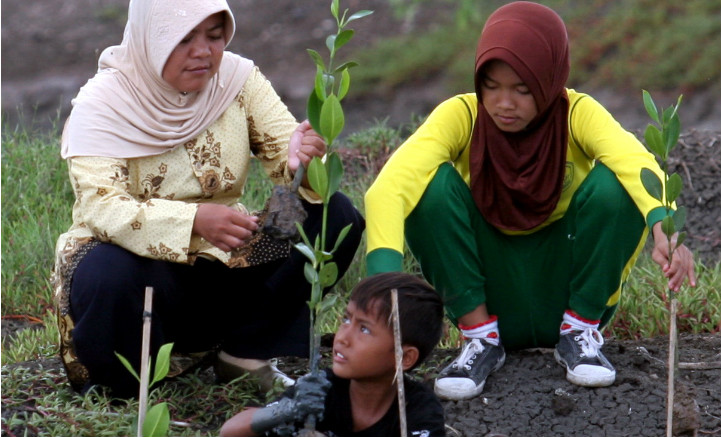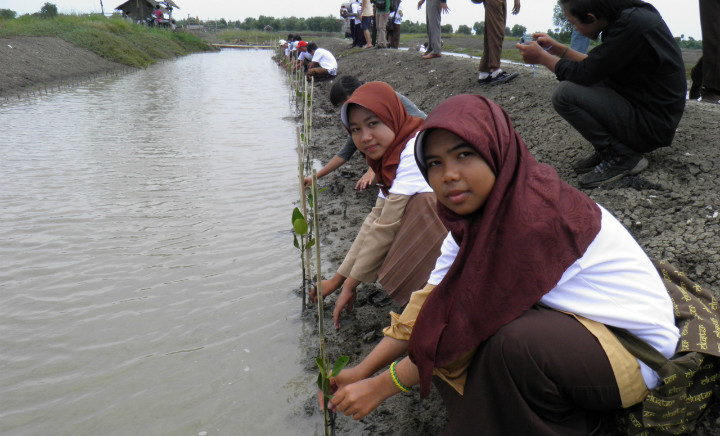Strengthening resilience by addressing climate change and managing ecosystems
Natural and man-made disasters have been increasing dramatically over the past few decades, with climate change contributing to even more extreme and unpredictable weather.
Combined with the high vulnerability of communities, especially in the southern hemisphere, degradation and loss of ecosystems intensify the hazards that lead to increased disaster risks.
The poorest people in the least wealthy countries suffer disproportionately from disasters: lives, assets, products and crops are lost. Hard-won reductions in poverty are wiped out, and communities are caught in a vicious circle where poverty creates vulnerability and disasters increase poverty.

To ease this situation, Partners for Resilience (PfR) aims to drive strategies that increase the resilience of vulnerable people in disaster-prone areas. Formed in 2011 and based in the Netherlands, it is an alliance led by the Netherlands Red Cross, in collaboration with the Red Cross Red Crescent Climate Centre, Cordaid, CARE NL and Wetlands International.
The PfR programme puts people at the centre of development efforts. It promotes the key role of communities in contributing valuable local knowledge and participating in decision-making, as they have the best understanding of their specific capacities, needs and vulnerabilities. This helps reduce social tensions and the need for ongoing external support.
PfR works to strengthen community resilience through Integrated Risk Management (IRM). This approach recognises the importance of ecosystems and climate to livelihoods. It sees risk as a convergence of factors, including natural-resource management and socioeconomic vulnerabilities. This in turn affects the strategies employed to reduce risks. IRM works on the understanding that risk reduction must integrate climate adaptation and ecosystem management and restoration. By paying attention to climate variability and climate change, IRM not only looks at current weather-related risks, but also at hazards that may affect communities further ahead.
This approach has key consequences for communities and the civil society organisations that work with them. People can anticipate by planning, maintaining stocks, and organising early warning systems. IRM aims to help people adapt to changing risks, for example through expanding and diversifying their livelihoods, such as by using drought-resistant crops. This supports communities in transforming themselves to address the root causes of risk, and in engaging with governments, the private sector and other stakeholders to find solutions. Mr Achhelal Padean, a Disaster Risk Reduction (DRR) Committee member from Boohtak in Bihar State, India, highlighted how developing a local DRR plan “really changed our lives in a very positive way. Our experiences should be replicated in all villages!”
PfR in action in Indonesia
Indonesia was ranked the world’s fourth most disaster-prone country according to the United Nations Office for Disaster Risk Reduction 2015 report. It is highly vulnerable to climate change, with rising sea levels threatening 70 per cent of 1,500 municipalities nationwide.
Sikka in the East Nusa Tenggara province for instance, is regularly afflicted by coastal surges, flash floods and storms. For the people forced to live in dangerous zones and rely on the degrading environment, these conditions can be catastrophic.
One PfR initiative protects communities through the preservation of existing mangroves and the planting of new ones. By slowing the flow of tidal waters, mangroves offer natural protection against floods. Their roots also allow sediment to settle and build up, which protects the coastline from erosion. Furthermore, a variety of resources like fish, firewood and building materials come from the mangroves.

How PfR is looking forward
Beyond Indonesia, PfR works together with local implementing partners in nine other countries: Guatemala, Haiti, Ethiopia, Kenya, Mali, Uganda, South Sudan, the Philippines, and India. It is one of the biggest programmes of its kind in the world, having reached more than half a million people in nearly 600 communities during the initial phase of the project, from 2011 to 2015.
2016 to 2020 marks the second phase of the project, which builds on the learnings gained so far. The plan includes a Global IRM programme, which aims to contribute to building community resilience through international frameworks such as the Sendai Framework for DRR, the Paris Climate Agreement, and the Sustainable Development Goals. One of the key priorities is to strengthen the capacities of civil society organisations. The Global Programme also seeks to link global policy with national and local practice: it is time for local realities to be recognised in global agreements, and international decisions must be translated into national policies and local actions.
PfR is supported by the Dutch Ministry of Foreign Affairs.
Basic information
Activity name
Partners for Resilience (PfR)
Country
Indonesia
Duration
2011-2020 (2 phases)
Partners
Netherlands Red Cross, Red Cross Red Crescent Climate Centre, Cordaid, CARE NL, Wetlands International
Download the brochure, or visit their website for more information: http://www.partnersforresilience.nl/en/
Read a BBC report on the importance of mangroves and the work of one of the PfR alliance organisations, Wetlands International.


